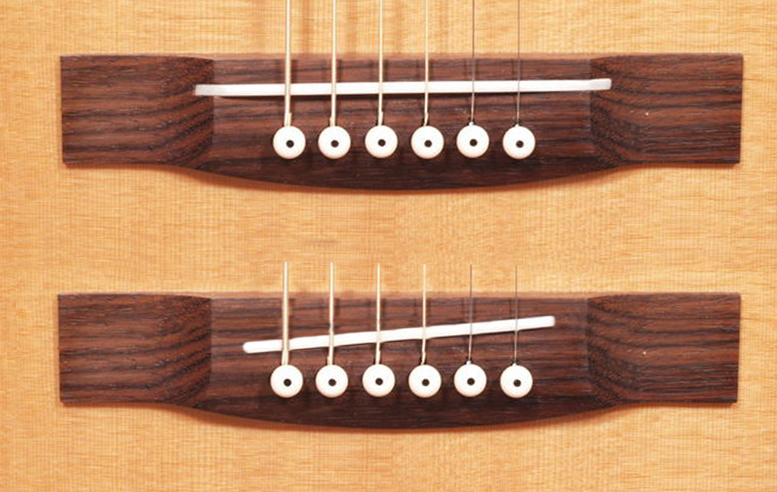Hi,
I have recently bought a Guild GAD F20, amazing guitar for the money, and everything I was looking for in a small bodied instrument. However, I have just discovered a design flaw that I missed before purchase. The guitar I gather is based on a "vintage" design and has a straight bridge saddle, that is it sits at 90 degrees to all six strings and has no compensation angle to allow for correct intonation; (ok, so I missed this at point of sale)!! The bottom strings (particularly the 5th. & 6th) are way sharp past the ninth fret. I string with regular Martin 80/20 bronze 12-54; neck relief seems correct; string clearance on the 6th. string at the 12th fret is 2.5mm
Re-routing the saddle slot is not an option as there is not enough room between the current saddle slot and the bridge pin to allow for the required adjustment (+/- 3/16" I believe) and to allow for the string break angle.
I am not a guitar technician, I'm simply a player who wants a guitar that is otherwise superb to play in tune past the ninth fret!!
Any advice would be greatly appreciated!!
Cheers.................Brian
Views: 1351
Replies are closed for this discussion.
Replies to This Discussion
-
Right on Paul!!
-
-
I've heard vintage enthusiasts complain bitterly about how the dot markers on the reissue are 1/64" closer than the original.Had they slanted the saddle, chances are someone would have complained that the reissue plays in tune while the originals didn't..
I had a customer that glued pieces of bone to the back of the exposed part of the saddle to make an instrument play in tune, it worked very well and had no noticeable affect on the tone.
-
-
There are guitar owners and guitar players, and the market will usually step up to meet the demands of both. No one's going to change that, so you just have to get used to judging each piece for what it is.
This is certainly one of the more comical features though, as I've not had many clients asking to have saddle slots plugged and straightened on their Chinese import guitars to make this feature fit vintage specs (which I don't know if ever existed on any vintage Guild of this style to begin with). I would love to have been a fly on the wall when this decision was made.
-
-
Some of the Chinese Guilds had inexplicably dumb mistakes, such as this. The old Guilds always had a slanted saddle, though the angle was rather wimpy. A parallel saddle is simply crazy. Several folks I ran into declined to have them fixed and simply sent the guitars back for a refund, but a few got the real bridge conversion, which looks like the lower of these two:
 There is no way of tweaking the saddle where it is. I have a piece about intonation, saddle positioning and so on here.
There is no way of tweaking the saddle where it is. I have a piece about intonation, saddle positioning and so on here.I recommend starting over with a new bridge, and doing a closed-end drop-in saddle. The guitar is quite worth it.
-
-
Hi Paul, thanks for the reply.
I have bookmarked your website since I discovered it recently, full of useful and informative information and like many others, I truly thank you for making the knowledge and experience you have, available to one and all.
Sadly, I decided that the guitar was not worth the expense (at least here in the UK) of having all the surgery that it needed (as you describe above) to correct the fault, I was equally concerned about any complications or other issues it may lead to later. As I have already said it was otherwise a truly superb instrument.
The retailer took it back, less a small "usage" fee and I have chosen a Takamine; all solid wood (spruce / rosewood) and sounds equally good, if not better than the Guild, but more important, plays in tune all the way up the neck!!
Once again thank you so much for your input and for your valuable website!
Cheers.........Brian
-
-
The old Guild F-20 definitely had a slanted saddle, though the compensation was not as much as on most modern guitars. This photo is a pic of a 1956 F-20, serial number 3503, first year of the model. You can clearly see the (very slight) compensation. (Sorry that the photo barely shows the bridge, but when I took it, I wasn't focusing on the saddle or the bridge).
-
- ‹ Previous
- 1
- 2
- Next ›
© 2025 Created by Frank Ford.
Powered by
![]()
